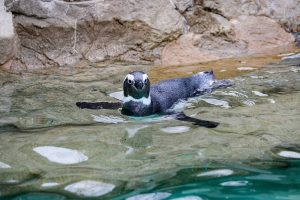– Introduction to the ecological significance of penguins
– Overview of the diverse species of penguins and their habitats
– The challenges facing penguin populations: Climate change and human activity
– Strategies for penguin conservation and the role of zoos in wildlife preservation
– Insight into penguin behavior, biology, and reproduction
Penguins, with their distinctive black and white plumage and upright walk, are among the world’s most recognized and beloved birds. These flightless birds have fascinated scientists and nature enthusiasts with their remarkable adaptations to cold environments, complex social behaviors, and extraordinary swimming abilities. This article seeks to delve into the ecological significance of penguins, discuss the diversity among penguin species and their habitats, highlight the challenges they face from climate change and human activities, explore the conservation efforts in place to protect them and provide an insight into their unique behaviors, biology, and reproduction.
Ecological Significance of Penguins
Penguins play a crucial role in their ecosystems, particularly in the Antarctic and sub-Antarctic regions where most species reside. As predators, they help maintain the balance of marine food webs by consuming large quantities of seafood, including fish, krill, and squid. Moreover, their excrement, rich in nitrogen and phosphorus, fertilizes the ocean and facilitates the growth of phytoplankton, which serves as the foundation of the marine food web. Understanding penguins’ ecological role is essential for conserving these environments and the myriad of life forms they support.
Diverse Species of Penguins and Their Habitats
There are approximately 18 penguins, each adapted to their specific habitat, ranging from the icy shores of Antarctica to the temperate beaches of New Zealand and the Galápagos Islands near the equator. The Emperor Penguin is the largest species, famous for its incredible endurance in the harshest cold conditions. In contrast, the Little Blue Penguin, the smallest species, inhabits the coastal areas of Australia and New Zealand. The distinct adaptations of each species to their respective environments underscore the incredible diversity within the penguin family and highlight the importance of habitat preservation for their survival.
Challenges Facing Penguin Populations
Climate change increasingly threatens penguins, which impacts their habitat and food availability. Melting ice sheets and shifting weather patterns disrupt the breeding and feeding behaviors of some species, while human overfishing depletes their food sources. Pollution, especially oil spills, poses a grave threat to penguin populations by endangering their health and reducing their insulating abilities. Addressing these challenges is vital to ensuring the survival of penguin species in the face of a rapidly changing environment.
Strategies for Penguin Conservation
Conservation efforts for penguins include habitat protection, sustainable fisheries management, and pollution control measures. Protected areas on land and at sea provide safe breeding and feeding grounds free from human disturbance. Zoos and aquariums play a pivotal role in wildlife preservation by participating in breeding programs, educating the public about conservation, and conducting vital research on penguin health, genetics, and behaviors. Collaborative international agreements and policies are essential to address the global threats affecting penguins, such as climate change and marine pollution.
Insight into Penguin Behavior, Biology, and Reproduction
Penguins are known for their social behavior, often forming large colonies to breed and nurture their young. Their reproductive strategies are fascinating, with some species, like Emperor Penguins, undertaking remarkable journeys and enduring harsh conditions to mate and raise their offspring. Penguins are also exceptional swimmers, with adaptations such as streamlined bodies and powerful flippers enabling them to reach speeds up to 15 miles per hour in water. These extraordinary capabilities and complex social structures and behaviors make penguins a subject of endless fascination and importance for scientific research.
The conservation of penguins and their habitats is critical not only for the survival of these charismatic birds but also for the health of marine ecosystems worldwide. Through scientific research, public education, and targeted conservation strategies, it is possible to protect penguins from the threats they face and preserve the rich biodiversity of their environments for future generations. Engaging with and supporting zoo management and wildlife conservation efforts are effective ways to contribute to the preservation of penguin species and the ecological balance of their habitats. By fostering a deeper understanding of penguins, their ecological roles, and the challenges they face, we can inspire greater commitment to their protection and the well-being of our planet.


